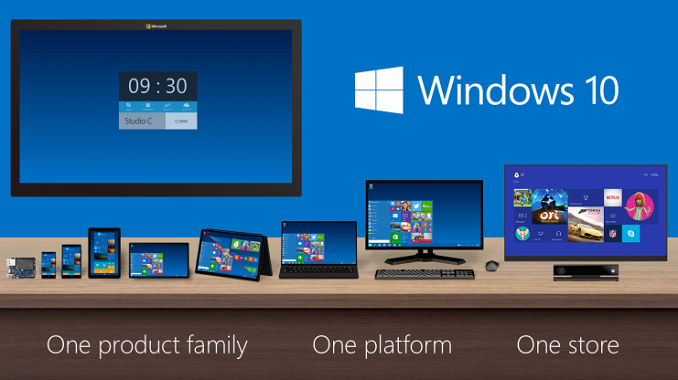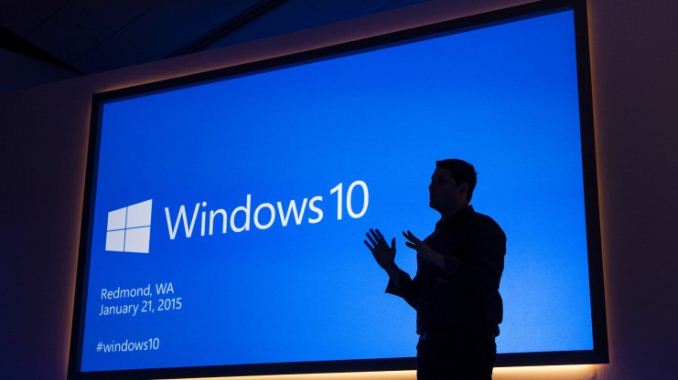Microsoft Announces Free Windows 10 Update
by Brett Howse on January 21, 2015 5:22 PM EST- Posted in
- Operating Systems
- Windows
- Microsoft
- Windows 10

Today Microsoft took the wraps off of their updates to Windows 10, and announced many of the consumer facing features that will be coming with the next version. Likely the biggest announcement of the day came right at the start of the keynote, with a drastic change in the Windows licensing model. There is a lot to discuss, and the keynote itself was over two hours long, so we will cover the rest of the announcements in a separate piece, but due to the significance of this change, it is important to go over the details.
The Windows 10 update will be free for all users of Windows 7 and Windows 8 for one year after launch, which is of course a drastic change over how Windows has been updated in the past. It would be a bit surprising if the free upgrade does not get extended, but for now they are only committing to a free upgrade for a year. However, once updated to Windows 10, the device will kept current and supported over the lifetime of the device. I have already heard “Where is the money going to come from” but really this is sort of a moot point anyway, since the vast majority of people do not pay to upgrade their software anyway. Most of the Windows upgrades come when a person upgrades their device, and at least as far as right now, Windows still has a licensing cost to the OEMs except for some of the smaller, lower cost devices. The initial sale of the device will be the income source, as well as promoting their various online services such as OneDrive, and Office 365, which can bring in subscription based fees. In a way, it is similar to how Apple treats OS X, with the price of the operating system built into the overall system, and then updates can be made available inexpensively going forward.
Really this is about moving the platform forward, and trying to avoid another Windows XP where a large chunk of their user base gets out of sync with the latest versions of software, which causes developers to have to cater to the old platform and not utilize the new features. Windows 7 certainly has the capability of becoming the next Windows XP, so this is an important step if they want developers to build out the new ecosystem.
This is a huge change to Windows, and will move Windows into the realm of being treated as a service. Not only will it move people off of the old platforms much quicker (who does not like free?) it will also allow Microsoft to keep the platform moving forward in the future. The mobile operating systems have already shown how effective this can be, with new APIs and OS features being able to be used by developers much quicker than on the desktop.
This is a key point to moving developers and end users towards the Universal App model, so strategically it makes a lot of sense. If the majority of people are still running a version of Windows that does not support Universal Apps such as Windows 7, it is going to be very difficult to get major developers to build out the platform.
Also, I believe it is also a play towards improving the app situation on Windows Phone. As we will detail in a later piece, Windows Phone is going to be gone, and replaced with just Windows. Windows 10 already has a better mindshare than Windows 8 ever did, so focusing on helping developers build apps that can reach all of their platforms can only help.
Perhaps we now know why Windows 9 was skipped – Windows 10 could be the last major Windows release, with all future versions being an extension of Windows 10.
Source: Microsoft











47 Comments
View All Comments
MrTeal - Thursday, January 22, 2015 - link
Is it known whether you need to have a current install of 7/8 in order to get the free update, or can you do a clean install of 10 and use your 7/8 key to activate the license?Ahnilated - Thursday, January 22, 2015 - link
It seems I will still be staying away from a new version of Windows (hugs his Windows 7). I don't want the tiled look at all, I don't care if you give me a start menu excuse, my PC is NOT a tablet. I also don't want their walled off apps.kyuu - Thursday, January 22, 2015 - link
There is literally no software that you can run on Windows 7 that won't run on 10, so the thought that you're stuck with "walled off" apps if you move is simply wrong.As for the tile thing, give it a rest. If you're seriously going to refuse to update (for free) because of some tiles in your start menu, you're beyond being reasoned with. And the start menu is customizable; you don't have to have tiles in there if you don't want.
Michael Bay - Tuesday, January 27, 2015 - link
It`s the same crowd that somehow lived with WinXP until 2010 or so.Hopeless.
Wolfpup - Thursday, January 22, 2015 - link
This blows my mind, though in some ways isn't surprising. I vastly prefer Windows to any other OS though so I hope this shift doesn't eventually lead to breaking things I love about Windows like it's backwards compatibility and well thought out interface. The pointless yearly updates that Apple feels compelled to do seem gimmicky and broken most of the time...I'm wondering how they'll handle Pro though...assuming there will even be different versions of 10. Like do you only get 10 "home/basic" free, and have to pay for a Pro upgrade even coming from 8.1 Pro? Oh well, either way that'll still be cheaper, and nice considering I'm running more PCs now than ever (and planning on getting at least one or two Windows Tablets soonish too, to replace Android and my iPad 2)
name99 - Thursday, January 22, 2015 - link
My guess is that that's the plan for the revenue model --- home/basic is free (to get the developers on board for a large volume of users) but enterprise features will cost. The question then is, what counts as enterprise features, now and going forward? (Compare with how Intel does something similar for x86.)FOR EXAMPLE MS could consider something like multicast TCP as an enterprise feature, which could be pretty irritating for home users, especially if performance features like that are all you really want, not all the additional Active Directory and server stuff.
Similarly maybe support for a maximum of (4? 6? 8?) CPUs, each with two hyperthreads, maybe a maximum amount of memory supported, maybe even a maximum amount of storage supported?
nils_ - Sunday, January 25, 2015 - link
I suppose you're talking about multipath TCP? Enterprise features probably include things like Active Directory, Remote Management and the like.ThisWasATriumph - Thursday, January 22, 2015 - link
I wonder what video cards will still get driver support for Windows 10. Or whether Windows 10 is backwards compatible with 7 or 8 drivers...Michael Bay - Tuesday, January 27, 2015 - link
Well, at least for now it is.'nar - Thursday, January 22, 2015 - link
Last version of Windows? Skynet will become self-aware in six months. :)The real question is do you need Windows 10? Do you WANT Windows 10? If so, great, get it. "Free" - The ultimate example of something you don't need at a price you can't refuse. Here is another; I want to give you a rufie, will you eat it?
I don't want more problems, I want consistency. Consistency with what is up to the user. That was the main problem with Win8, it did not give the user a choice.